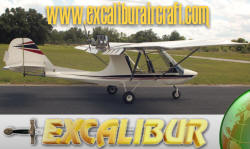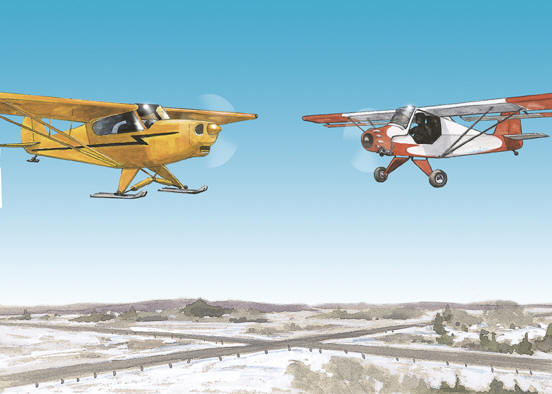|
When all of a sudden you hear this
God Awful roar and at the same time hear a screeching sound like metal on
metal, your ultralight aircraft pitches forward and down, something
hits your rudder, and you see a set of conventional size floats pass by
the top of your windshield. On landing you find that your king post has
been damaged, and your rudder fabric torn.
Now picture yourself coming in for a landing in your little Buccaneer
Amphibian after a nice relaxing flight over your local lake, and are
setting up to land back on your mile long sod field. At about 300
feet in the air you hear a scratching sound like something is moving along
the bottom of your hull, then your plane pitches over to the left.
As it pitches you apply full power and climb out, glancing over to see
a Quicksilver MX in the process of taking off, the pilot unaware that his
king post has just scratched the bottom of your hull!
The above are only two of a number of incidents that have happened in
real life. Add to that last year I lost a friend and fellow pilot due to a
mid-air collision between his Kitfox and a conventional aircraft.
The skies we fly in are not nearly as dangerous as the roads we drive
on, but unlike roads our routes are not confined to the area between the
lines in one direction or the other. There is no aspect of our day to day
life that can prepare us for locating things in the sky as we fly.
Our eyes have been trained to take in the stop lights, brakes lights,
turn signals, oncoming traffic, and if you are a motorcyclist the car
coming up to a stop sign from the side road, or that car just about to
enter the passing lane. But in the air they have none of this to relate
to, and instead of a path that is 35 feet wide with no depth or altitude -
they now have to content with a path 20 miles wide and 1,000's of feet
both above and below.
It is interesting in studying ultralight accidents over the last 30
years, and cross referencing it to my own experiences - most of our
ultralight accidents involving mid air collisions, or close calls are all
in the area of our home bases, happen during the day in good VFR
conditions.
Why? Because that is when we fly our little planes, and that
is when and where we are most likely to encounter other aircraft taking
off or flying in a defined circuit or pattern. Another problem is that
most of us fly to RELAX, to get away from all the noise, traffic, and
congestion, so our guard has been let down!
Another interesting fact is that most of our accidents happen when two
speeds of aircraft are either landing or taking off going in the same
direction. That is, a slower plane is landing as a faster and higher plane
is also landing.
In the case above I was landing in my Buc while the Quicksilver was
taking off. I was unaware he was taking off - he was unaware I was
landing. In the case of the conventional float plane I was cruising along
below him unaware that he was preparing to land.
So what can we do to help prevent these kind of close calls and
accidents? Well the first step is to train our eyes on how to look
for other aircraft when flying. In training a problem that students have
is if they continually keep glancing at their instruments as they land,
and then back out at the runway - they loose "focus".
That is the eye
looks at something near to them adjusts for light, depth, (while the brain
adjusts for familiarity, he knows what he is looking for on the dash) and
then he looks out into the distance where the eye has to refocus with
really no depth perception - that is there is no dash to focus on just
20 miles of sky.
If the student continually watches the instruments he looses his
"perception" of speed, altitude and distance. Studies show that it can
take two seconds or longer for the eye to adjust EVERY TIME this happens.
At 60 mph you are covering a mile a minute, nearly 100 feet per second.
Now add in the reaction time that would be need to avoid a collision - say
10 or 12 seconds (to first recognize then react) and you have traveled
over 1000 feet.
Lets look at some of the problems our poor old eyes face when we fly .
We've talked about the problem the eyes and brain have adjusting to
things near and far. But what else will effect our "collision avoidance
judgment"?
- weather conditions - clear days versus hazy days
- windshield condition - clean versus dirty or scratched. Remember
when you look at a plane in the distance it will first appear as a
"SPOT" on the windshield. But if you already have a number of
"SPOTS" you may not catch the one that is closing on you at 150 mph.
- where the sun is - a sun glaring in the windshield makes seeing
distances impossible.
- pilots eye condition - wearing glasses or even sun glasses
- optical illusions - how many times have you been flying, see
something shiny in the distance that looks like a large craft coming at
you only to have it turn out to be the sun reflecting of a building?
Seen what looks to be another plane doing aerobatics in the distance
only to have it turn out to be a model plane just in front of you.
- aircraft design - many craft have BLIND spots they must be
recognized and compensated for.
- Some pilot do not properly "FIT" their aircraft, that is they do not
have a good view over the dash because their seats are too low, or the
windshield area restricted.
- Stress, alcohol, fatigue,
- Distractions - like an engine that is not running right, or a engine
gauge suddenly starts to move into the danger zone.
- Daydreaming
- Color of the planes - picture two white planes over a frozen snow
covered lake, two dark colored planes just before dusk.
- A dark aircraft below you over a dark field or set of buildings
But is there one good way to scan? If there is I haven't found it. Each
plane I have flown is different. Each has it's own little blind spots,
which only seem to become evident the more the plane is flown. Thus the
pilot that is "married" to his plane will be able to "find that certain
way of doing it" that is comfortable for him and his "partner."
Also each flight "phase" generally requires a different kind of scan
There some techniques that all pilots should start from and then build
on.
- Don't glance quickly!
- Don't stare at one area for long periods of time.
- When you look at an area look at the area up and down in a specific
area. This area should be about 10 to 15 degrees UP-DOWN-LEFT-RIGHT
looking for movement, then move over a little, and then repeat. This may
sound like it will take a long time - in fact it takes relatively little
time when practiced.
- Look first to the area that poses the most danger to you for the
"phase of flight" you are in. If you are turning onto base a good look
before the turn, during the turn, and ahead
of the turn. AND look over to the area that other planes might
be coming in at you on if their circuit were to be farther out than
yours.
- if you have radios CLEAR yourself before any and all turns
- While on approach especially on the downwind leg look for shadows of
aircraft on the ground. By practicing this you will get in the habit of
looking down while landing - and a plane this is hard to see above or
below you will usually cast a shadow to one side or the other of it.
- A good practice to get into is doing gentle "S" turns while climbing
out or landing
- Ultralight pilots should aim to touch down 1/3 of the way down the
runway. Why? because conventional pilots generally aim for the numbers
at the end of the runway - thus your higher approach will make you
visible to the conventional plane below you, take you farther down the
field with more time to react, and in the case of an engine out you can
still make the field.
- if you are at altitude and flying cross country then a scan 60
degrees to the right and left from a center line and 10 to 15 degrees up
and down should allow the eyes to catch movement all the way over to the
side windows.
Hopefully the above will help you fly safely - the addition of STROBE
LIGHTS on your wing tips and fuselage (which I just happen to have in
stock), a landing light or landing lights on the nose or wing struts.
Aircraft colours such as yellow or other contrasting colours to the sky
and clouds (this from a man who is totally colour blind) will also help in
making your plane more visible in the sky.
A couple of questions you should be able to answer - if not hit the
books!!!
When two aircraft are converging head on - what should each pilot do?
How do you properly overtake a slower aircraft?
U.B. Judge - Ultralight Aircraft News

During a three-year study of midair collisions involving
civilian aircraft, the National Transportation Safety Board (NTSB)
determined that:
1. The occupants of most midair's were on a pleasure flight
with no flight plan filed.
2. Nearly all midair collisions occurred in VFR conditions
during weekend daylight hours.
3. The majority of midair's were the result of a faster
aircraft overtaking and hitting a slower aircraft.
4. No pilot is immune. Experience levels in the study ranged
from initial solo to the 15,000 hour veteran.
5. The vast majority of midair's occurred at uncontrolled
airports below 3,000 feet.
6. Enroute midair's occurred below 8,000 feet and within 25
miles of the airport.
7. Flight instructors were onboard one of the aircraft in 37
percent of the midair's.
Almost 50 percent of mid-air collisions result in at
least one death. Naturally, mid-air collision avoidance (MACA)
is an important aviation safety topic. With the sky becoming
more and more congested, the threat of a mid-air collision is
increasing.
According to the NTSB, the most probable cause of mid-air
collision is the “pilot in command failed to see and avoid other
aircraft.” Aircraft speeds today challenge our ability to “see
and avoid.”
Here are a few more facts about mid-air collision:
1. Mid-air collisions generally occur during daylight hours;
56% of the accidents occurred in the afternoon. 32% of the
accidents occurred in the morning. 12% of the accidents
occurred at night, dusk, or dawn.
2. Most mid-air collisions occur under good visibility.
3. Flight fatigue (fatigue resulting directly from flight
related operations) was not a major factor in mid-air
collisions. The average flight time prior to the collision is 45
minutes. This time varies from takeoff to over seven hours.
60% of the pilots on the mishap flight had been airborne thirty
minutes or less. Only 6% had been flying longer than two hours.
|


